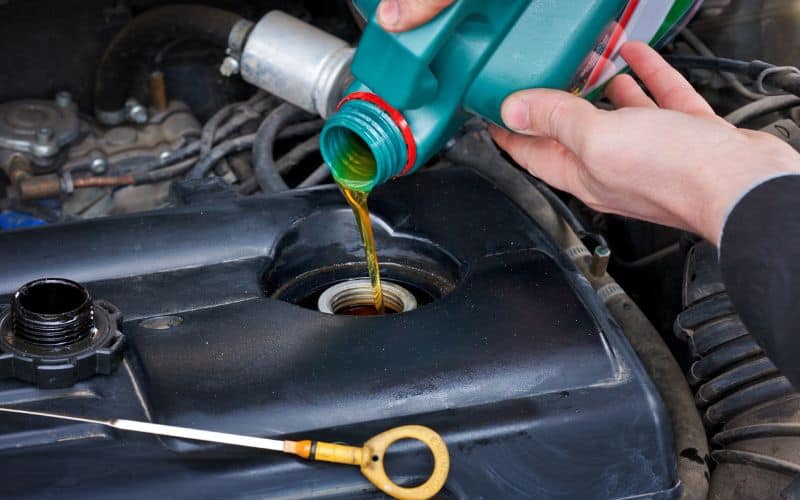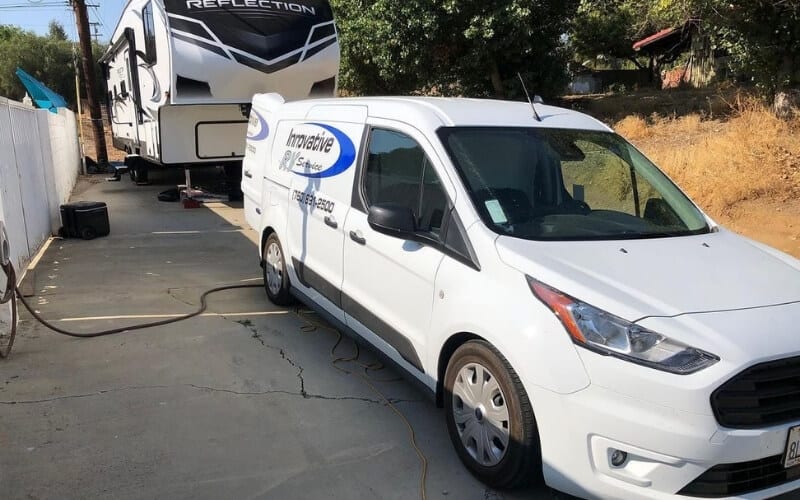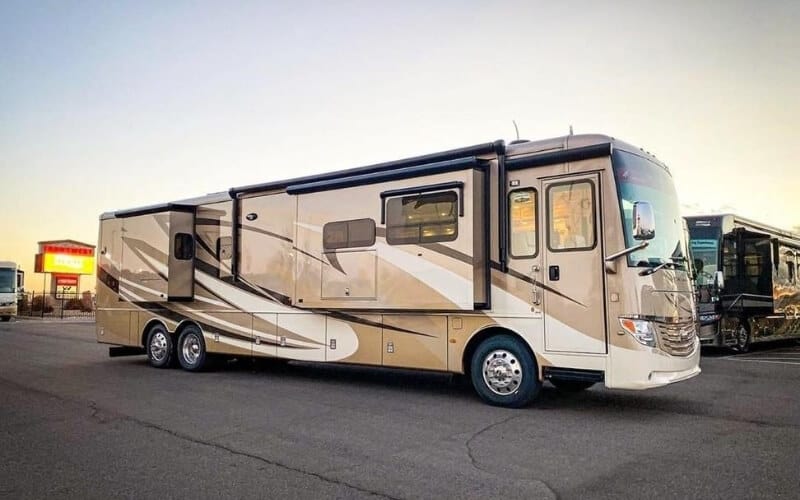Motorhomes are vehicle and functional living spaces all in one. Their internal combustion engine needs routine oil changes and maintenance just like any other vehicle engine.
Though motorhome RVs don’t tend to get as frequent use as your daily driver’s car, you can’t use the mileage as the only metric in determining when to get the oil changed. Other things like storage time, engine type, and how the engine is used are also key factors.
This probably makes you wonder how often I need to change the oil in my RV?
Ideally, you want to change the oil in an RV with a gasoline engine every 3,000 to 5,000 miles. A diesel motorhome should be changed every 5,000 to 7,000 miles.
However, this is just a general guideline. With the infrequent use and the heavy strain RV engines are put through, mileage isn’t the only factor influencing when the oil needs to be changed.
To help you decide just how often to change your RVs oil and how to do it cost-effectively, we’re going to have to pop the hood on some important details.
Why You Need to Change the Oil in an RV
Oil plays a critical role in lubricating the moving parts of an internal combustion engine. This also means that engine oil is exposed to a lot of heat, especially in RV motorhome engines which are tasked with moving the heavy load of the living quarters at highway speeds, up hills, and down rough gravel roads.
All this heat causes the engine oil to degrade slowly. The hydrocarbon chains start to break down, and the once-amber engine oil starts to turn darker and darker brown.
The dirtying of the oil can be accelerated by running the engine hot. Dust and other debris that makes it into the internal combustion system can contaminate the oil with fine particulate material.
Older engines and engines that frequently run hot or go too long without an oil change can also get tiny metal flecks in the oil. This is from excess wear and tear on the pistons and other moving components in the engine, which further degrades the oil’s ability to lubricate.
It’s also worth bearing in mind that motor oil starts to oxidize and break down over time. The longer your RV sits without running, the more oxidation is likely to occur. This can lead to needing an oil change earlier than your current oil’s 3,000 or 5,000-mile rating.
How To Check RV Engine Oil
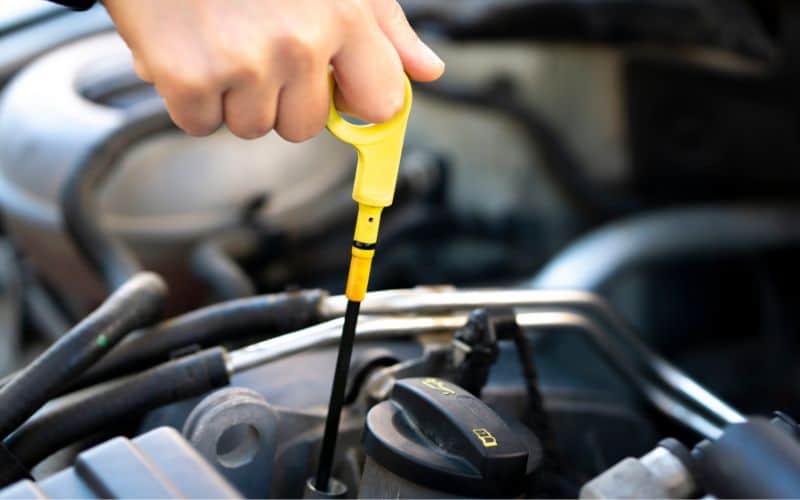
It’s wise to check your RV’s engine oil before, during, and after every trip. You should also check it first thing in the spring when you take your motorhome out of winter storage. The goal is to check both the oil level in the engine and the color of the oil on the dipstick.
Step One: Stop the engine and let it cool down for at least 10 to 15 minutes. This will let all the engine oil settle into the oil pan for the most accurate possible reading.
If the oil on the dipstick is below the lower mark, you likely need to add more. Though you should double-check the oil again before adding more oil just to make sure your reading is accurate. You can badly damage an engine if you accidentally overfill it with oil.
While checking the oil level, you should also look at the oil color on the rag. Ideally, you want something that’s amber or medium brown. Your RV likely needs an oil change if it’s dark brown, gray, or turning black.
It would help if you also looked for tiny flecks of metal in the oil on the rag. This is a sign that the oil is degrading and might also indicate a more serious problem developing in the motorhome’s engine.
Do Gasoline & Diesel RV Engines Use The Same Oil?
The oil used by gasoline and diesel engines is slightly different. Diesel engine oil has lower sulfur levels and anti-foaming additives. While you might be able to get away with 10W-30 in a pinch, it’s best to use the correct type of diesel engine oil recommended in your RV owner’s manual.
Factors Determining When to Get an RV Oil Change
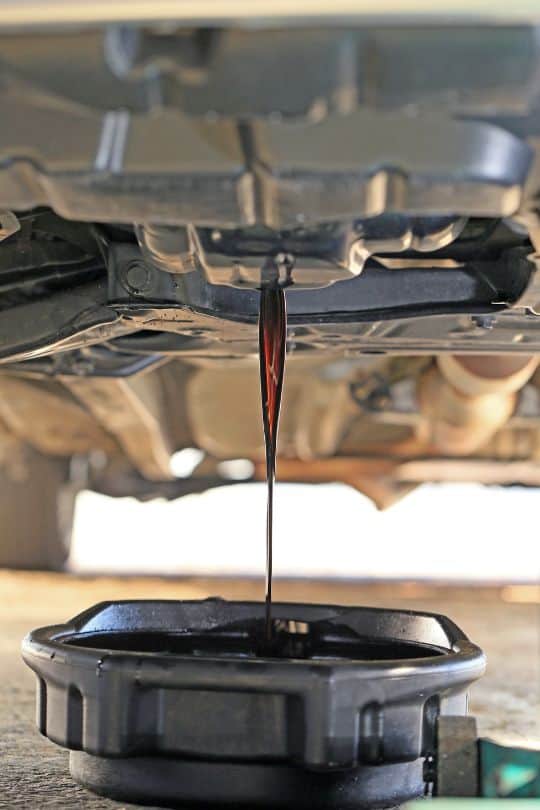
Mileage is always a prime factor influencing when changing your RV’s oil. If the last oil you had put in it was rated for 3,000 miles, then you go on a trip that’s 1,500 miles one way and 1,500 miles back; you absolutely need to change your RV’s oil.
Even if you’re close to the mileage limit for your last oil change, you should still consider changing the RV oil to err on the side of caution.
Though there are certainly other factors that could tell you to get an old change before you hit the mileage limit. This includes things like:
You should also note that many RV manufacturers are adding detailed stipulations in their warranty coverage for routine maintenance.
This might require you to have an oil change performed on your motorhome every three months, six months, and/or miles. The RV warranty might even include language on the type of oil you must use.
If you fail to meet these stipulations, and something happens to your RV’s engine caused by improper oil change habits, they might not cover the repair!
Where Is The Best Place To Get An RV Oil Change?
If you have a Class B motorhome, you can get your oil changed just about anywhere that you might get an oil change for a car or an SUV.
Larger RVs like Class C or Class A motorhomes are generally too large to fit into the standard bay at some discount Zippy-Lube franchise. With these RVs, your oil change options are:
Setting aside the idea of changing the oil yourself for the moment, your best value for getting your RV oil changed is to go to a dealership. The dealership you bought the RV from might even have given you a routine maintenance package that includes a number of free or discounted oil changes.
The benefit of going to an RV dealership with a service center is that they are the most familiar with RV engines. They are more capable of spotting any possible maintenance issues or hidden signs that the oil might reveal to them.
If your RV is under warranty, they can provide you with the kind of documentation that RV manufacturers and insurance companies want to see if you need to file a claim later.
How Much Does An RV Oil Change Cost?

Assuming you don’t have an oil change discount through an RV dealership, you can expect a motorhome oil change to cost you between $80 to $125. You might be charged toward the high end of that range for a large diesel pusher Class A motorhome and lower than that range for a Class B motorhome with a gasoline engine.
An RV oil change usually includes the following:
Many times, they’ll also check your RV air filter. If there’s a problem like a mouse nest or it’s overly dirty, the RV service center can replace it for you. Though this is the sort of thing, you can do yourself for cheaper.
How To Change Your Own RV engine Oil
Let’s say you’re mechanically inclined and have the tools to try a DIY oil change. Just keep in mind that the volume of oil you are dealing with is going to be more than you would with even a one-ton pickup truck. In the case of a Class A motorhome, it’s likely much more!
So, before you commit to changing your RV oil, ensure you have a big collection pan to hold it all. You should also have a plan in place for how to dispose of the old oil once you drain the RV’s oil pan.
You’ll also need to make sure that you are sourcing and using the right type of oil stipulated in your RV owner’s manual and/or your RV’s warranty coverage. Then make sure that you have the correct oil filter for the engine.
When you’re ready, you can change your RV’s oil using the following steps.
Conclusion
Your RV will need an oil change every 3,000 to 5,000 miles or sooner depending on how heavily you use it and the appearance of the oil. If you took it out on a hard-driving vacation and the oil is dark or shows tiny metal flecks, then you should change it early, regardless of mileage.
You should also change your RV’s oil if it sits for more than three months or if your active warranty stipulates the oil change schedule to maintain coverage. You should also change the oil every spring when you take it out of winter storage to eliminate the old, oxidized oil.
The best place to go for an RV oil change is usually an RV dealership. They have the tools and expertise to change your oil and spot any other minor maintenance issues that need to be addressed. The dealership you bought it from might even offer discounted oil changes for returning customers.

